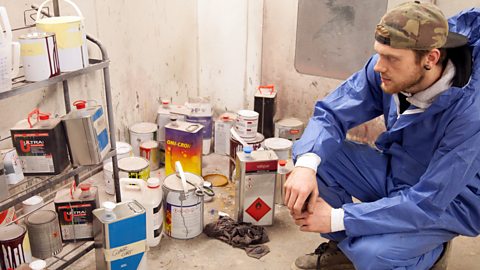How to calculate engine capacity
Watch the video to find out more.
Speaker 1: Come with me. I just want you to have a look at this static engine.
We've got some calculations to do to work out the capacity.
So to calculate this we need to use a formula.
We're gonna measure the bore radius times the bore radius times pi times the stroke, and then we multiply that by the amount of cylinders we have on the engine.
Speaker 2: OK. What does this symbol mean?
Speaker 1: This is pi, and it represents the figure 3.14, or rounded off to, we use that to calculate the formulas for circles.
Speaker 2: OK.
Speaker 1: So the stroke we know is 74 millimetres, so I'm gonna leave you with it, Danny.
Speaker 2: OK, brilliant. I'll get right to it.
Speaker 1: Thank you.
Highlight the mistake
Test your knowledge with this activity.
Work out engine capacity in stages
Watch the video to find out more.
Speaker: I need to add all of the measurements to this formula.
That's the bore radius times bore radius times pi times the crankshaft stroke times the number of cylinders.
This will give me the engine capacity.
First, I'll take the engine apart to get to the bore and measure its radius.
OK, I'll use the vernier caliper for this, this will give me a precise measurement to two decimal places.
The bore diameter measures 80 millimetres, but I need the radius, this is equal to half the diameter.
To work this out, I divide 80 by 2, that's 40 millimetres.
Now the crankshaft stroke, my manager gave me this information, that's 74 millimetres.
Finally, the number of cylinders, there are two here.
So I have all the information I need, now I just need to do my final calculation.
Find the radius for each diagram
Test your knowledge with this activity.
Finding the cylinder's capacity
Watch the video to find out more.
Speaker 1: (TO AUDIENCE) Now I have all of the measurements I need from the engine.
First, I times the bore radius by the bore radius then I multiply that by pi, then I multiply that by the crankshaft stroke, then by the number of cylinders, that's 743,552.
Speaker 2: (TO OTHER PEOPLE) Hi Danny, how are you doing?
Speaker 1: Hi Pete, I found the cylinder capacity to be 743,552, that seems a little high to me.
Speaker 2: We've got measurements in millimetres there and we need to convert it to centimetres as all motorcycle engines in the UK are measured in cubic centimetres.
So what we need to do, is divide it by a thousand.
Speaker 1: Oh, OK, so that would give us 743.
Speaker 2: That's correct, bike manufacturers would round it up to 750.
Speaker 1: Oh, OK, so it's a 750 engine.
Speaker 2: That's right, well done.
Speaker 1: OK, great.
Speaker 2: Now just put it back together again and we'll see how it runs.
Speaker 1: Oh, OK.
Convert cubic mm to cubic cm
Test your knowledge with this activity.
More on Automotive
Find out more by working through a topic
- count4 of 5

- count5 of 5
